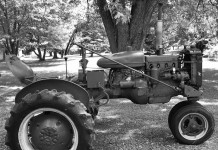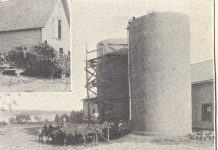Seventy years ago, the first of many millions of Jeeps saw the light of day. The origin of the sturdy little vehicles, which were universally used by all the allied armed forces during World War II and Korea, leads back to nearby Butler, Pa.
The Austin automobile had been developed by Englishman Herbert Austin, who began making the cars in 1906, and Austins were popular cars in Great Britain until 1987.
An American Austin Company was organized in 1929 in Butler, Pa., but the timing was terrible. Even though the cars were inexpensive and economical, with the Great Depression in full swing, not many cars had been built by 1934 and the American Austin firm was bankrupt.
New car
A super salesman named Roy Evans reorganized the company, renamed it American Bantam, and came out with an attractive little car with a more powerful engine. America just wasn’t ready for a small, economical car however and, by 1940, only about 6,700 cars were sold and the firm was nearly out of money.
There had been almost no vehicle development in the U.S. Army during the 1920s and ’30s, due mostly to tiny budgets and the hidebound horse mentality of many senior officers. Maj. Gen. George Lynch, chief of infantry from 1937 to 1941, on the other hand, was keen to find a small reconnaissance vehicle for his troops.
Roy Evans had long thought the Army should use his small cars and had even loaned a few to National Guard units to try, and Bantam had a lobbyist in Washington, Charles Payne, who was doing his best to promote the Bantam for military use.
With war in full swing in Europe and U.S. involvement likely, in 1940 Payne was pressing the Army hard to adopt the Howie “belly flopper” machine gun carrier. The Howie was little more than a platform on wheels but might use the Bantam engine and chassis.
The Army rejected the Howie, but Payne discovered they were looking for a quarter-ton truck and seems to have worked with Col. William F. Lee to make rough drawings of such a vehicle.
Necessary features
From this, Army specifications were drawn up — the car had to weigh less than 1,300 pounds empty, carry three or four men, be 4-wheel drive and have an engine of 85 feet-pounds of torque.
In June of that year Army representatives visited the Bantam plant in Butler and got an idea of what the firm could provide. Bids were requested, but the plans had to be ready in just 11 days and a prototype in 49 days. Both Willys and Bantam bid, but only Bantam agreed to meet the deadline, probably because they had already been working on the design.
Bantam employee Harold Crist designed the car and engineer Karl Probst was hired to refine the design and get the final drawings done in time to meet the deadline. The prototype was delivered Sept. 23, just under the wire, to Camp Holabird, Md., for testing, where it was declared a success.
Seventy cars, of which a few had 4-wheel steering as well as 4-wheel drive, were ordered from Bantam for further testing.
Next order
An order for another 4,500 was placed Dec. 21, 1940, but because of worries about Bantam’s ability to deliver and a need to avoid having all their eggs in one basket, along with the usual Washington lobbying and political considerations, this last order was divided into thirds, with Bantam, Willys-Overland and Ford each to build 1,500 vehicles.
Since it was deemed a war emergency, Bantam’s plans and drawings were turned over to Willys and Ford, each of whom built similar, but slightly different vehicles. Willys called their version the “Quad,” while Ford’s was dubbed the “Pygmy.”
It was alleged that Willys-Overland, which was in nearly as dire financial straits as Bantam, got the contract because John Biggers, head of the Office of Price Management, was from Toledo where Willys was located, and that Ford was chosen for political reasons.
A senate hearing under Sen. Harry Truman apparently found no wrong doing. Choosing the best features of each of the three versions, in July, 1941, the Army ordered 16,000 standardized quarter-ton vehicles and chose Willys to make them, said to be due to their more powerful engine.
Trailers
It soon was obvious that Willys couldn’t keep up with the demand and Ford was asked to produce the identical machines as well. In all this, the originator of the vehicle, Bantam, was ignored, although the firm was given a contract to make quarter-ton trailers to be pulled behind Ford and Willys jeeps.
Apparently American Bantam ended up furnishing only 1,570 quarter-ton trucks to the U.S. Army, although they also built 2,200 which were crated at the factory (under the supervision of Russian officers) and sent to Russia where they were well liked. Ford built 280,000 and Willys 363,000 jeeps before the end of the war.
As to how the quarter-ton truck came to be called a Jeep, there are several theories. However, Ralph Turner, an employee of Bantam who had helped build the prototype, told an interviewer in 1987, when he was almost 80, “I took the prototype to Holabird Proving Grounds. There I met Captain Eugene Mosley who was head of the test section. They took the little 1/4 ton truck for a test drive.
“The word ‘Jeep’ had been an Army cuss word up until that time. As we stood around wondering what to call the little truck, the word ‘peep’ came up. A Sergeant Littlefield who was standing nearby said, ‘No! Peep doesn’t describe the vehicle, but “Jeep” does.’
“Both Crist and I heard the remark, and the newspapermen got a hold of the remark. After that the word Jeep became the name of the truck.”
Name
In spite of uncertainty about the origin of the name, Willys managed to obtain a copyright on it after the war, obtaining exclusive rights to the use of the name Jeep, which is now owned by Chrysler Corporation.
Today, most people in most of the world are familiar with the Jeep, but few have ever heard of the American Bantam Company, or Butler, Pa., for that matter.
(Send suggestions, comments or questions to Sam Moore in care of Farm and Dairy, P.O. Box 38, Salem, OH 44460-0038; or via e-mail to: editorial@farmanddairy.com.)












